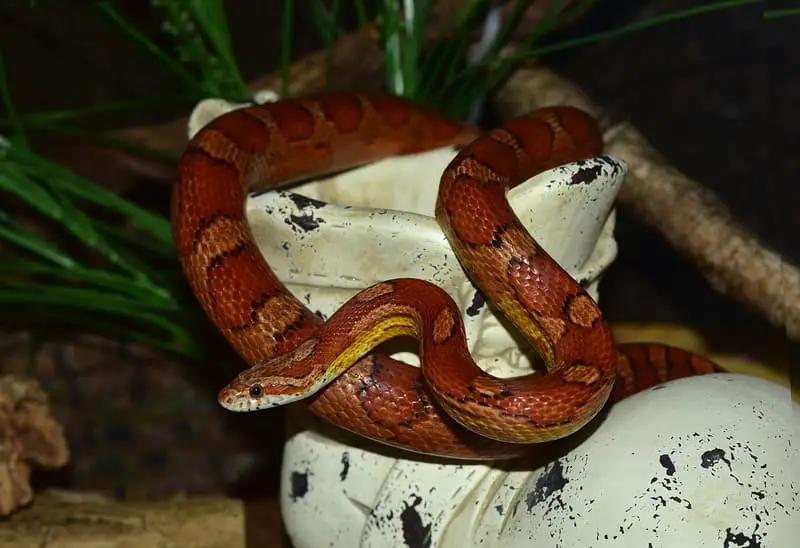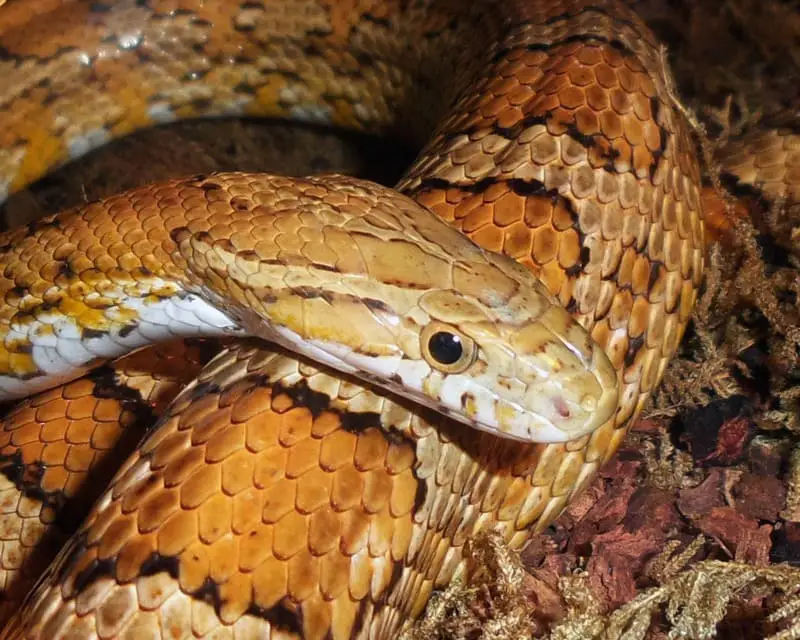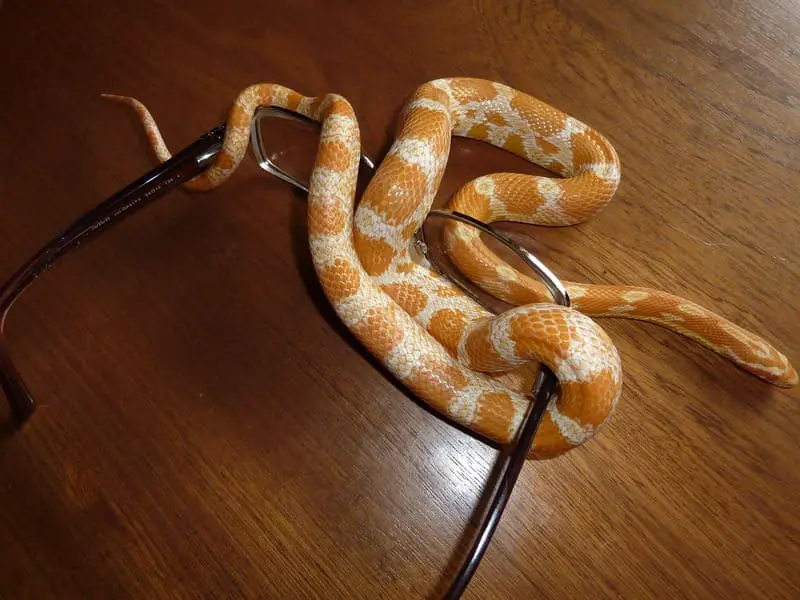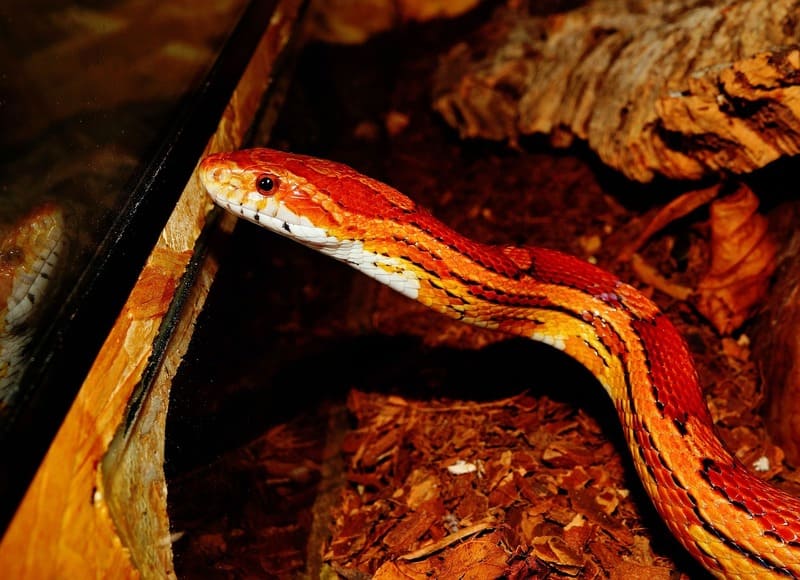When it comes to keeping a corn snake (Pantherophis guttatus) as a pet, providing the right enclosure is crucial for their well-being. Corn snakes, known for their docile nature and manageable size, make great reptile companions. To ensure a comfortable and healthy life for your corn snake, it’s essential to choose the appropriate terrarium size. In this comprehensive guide, we will explore the factors that determine the ideal terrarium size for a corn snake, as well as tips for setting up and maintaining their habitat.

Understanding the Corn Snake
Before discussing terrarium size, it’s important to understand the needs and characteristics of the corn snake.
Natural Habitat
Corn snakes are native to North America, primarily found in the southeastern United States. They inhabit a variety of environments, including forests, grasslands, and abandoned buildings. Understanding their natural habitat can help replicate suitable conditions in captivity.
Size and Growth
Corn snakes are relatively small compared to some other snake species. Adults typically range from 3 to 5 feet in length, with females generally being larger than males. As hatchlings, they measure about 8-12 inches in length. It’s important to consider their growth potential when choosing a terrarium size, as they will require more space as they mature.
Activity and Behavior
Corn snakes are primarily terrestrial but are also skilled climbers. They are known for their burrowing tendencies, often seeking refuge in underground hiding spots. Understanding their behavior is key to creating a suitable terrarium environment.
Temperature and Humidity
Corn snakes are ectothermic, which means they rely on external sources to regulate their body temperature. Maintaining the correct temperature and humidity levels in the terrarium is essential for their health and overall well-being.
Factors Influencing Terrarium Size
The size of the terrarium you choose for your corn snake is influenced by various factors. Consider the following aspects to determine the appropriate enclosure size:
1. Snake Size
The size of your corn snake plays a significant role in selecting the terrarium size. As mentioned earlier, corn snakes can grow to be 3 to 5 feet long as adults. Therefore, a hatchling or juvenile corn snake can be comfortably housed in a smaller enclosure, but as it grows, you’ll need to upgrade to a larger terrarium to accommodate its size.
2. Age and Growth
Consider the age and growth stage of your corn snake. A young snake can thrive in a smaller terrarium initially but will eventually outgrow it. Planning for their future growth is crucial to avoid the stress of frequent relocations.
3. Activity Level
Corn snakes are generally not highly active, but they do require space to move around, explore, and burrow. The terrarium should be large enough to allow for some freedom of movement without being excessively spacious.
4. Environmental Enrichment
Enrichment is an essential aspect of reptile husbandry. A well-designed terrarium should provide opportunities for the snake to exhibit natural behaviors, such as burrowing, climbing, and hiding. The enclosure’s size and layout should facilitate these activities.
5. Burrowing Space
Corn snakes enjoy burrowing, so the terrarium should have ample substrate depth for this behavior. It’s essential to provide a substrate that allows them to dig comfortably and build tunnels.
6. Heating and Lighting
The size of the terrarium also affects the efficiency of heating and lighting equipment. Larger enclosures may require more heating elements and lighting fixtures to maintain the necessary temperature and light levels.
7. Aesthetics
While the primary focus is on your snake’s well-being, the terrarium’s aesthetics are also essential. A well-designed enclosure not only provides for the snake’s needs but also enhances your enjoyment of observing and caring for your pet.

Terrarium Size Guidelines
To provide a comfortable and appropriate environment for your corn snake, it’s essential to follow some general guidelines for selecting the right terrarium size.
1. Hatchlings and Juveniles
Hatchlings and juvenile corn snakes can initially be housed in smaller enclosures, typically ranging from 10 to 20 gallons. A 10-gallon tank is suitable for very young snakes, while a 20-gallon long enclosure provides more space for juveniles. It’s essential to upgrade their habitat as they grow.
2. Adult Snakes
Adult corn snakes, with a length of 3 to 5 feet, require more substantial enclosures. A minimum of a 40-gallon breeder tank or equivalent-sized terrarium is recommended for adult corn snakes. However, providing an enclosure with a size closer to 55 to 75 gallons offers more comfort and space for the snake to move and explore.
3. Bioactive Enclosures
Bioactive setups, which incorporate live plants and a self-sustaining ecosystem, can be larger than traditional enclosures. A bioactive terrarium for an adult corn snake may need to be even more spacious to accommodate the plants and other inhabitants. Consider a 75 to 100-gallon enclosure for a bioactive setup.
Setting Up the Terrarium
Once you’ve determined the appropriate size for your corn snake’s terrarium, it’s crucial to set up the enclosure correctly to meet their needs. Here are some steps to follow:
1. Substrate
Choose an appropriate substrate for your corn snake’s terrarium. Substrates such as aspen shavings, cypress mulch, or coconut coir are commonly used. These substrates allow for burrowing and provide a comfortable surface for the snake.
2. Hiding Spots
Provide multiple hiding spots in the enclosure. Half logs, cork bark, or commercially available hides work well. Having hiding places on both the warm and cool sides of the terrarium ensures that the snake can choose the most suitable spot for its temperature and security needs.
3. Temperature Gradient
Create a temperature gradient within the terrarium. Corn snakes require a basking spot with temperatures ranging from 85°F to 90°F (29°C to 32°C) and a cooler area around 75°F to 80°F (24°C to 27°C). Use heat mats, ceramic heat emitters, or heat lamps to achieve the appropriate temperatures.
4. Lighting
Corn snakes are primarily nocturnal and do not require UVB lighting. However, providing a light cycle can help regulate their circadian rhythm and mimic natural day and night cycles. Use a simple light timer to achieve this.
5. Climbing Opportunities
As mentioned earlier, corn snakes are skilled climbers. Incorporate climbing opportunities in the form of branches or climbing structures in the terrarium to stimulate their natural behaviors.
6. Water Source
Include a clean and shallow water dish in the enclosure. Make sure it’s large enough for the snake to soak if needed and that it’s changed and cleaned regularly to maintain water quality.
7. Hydration and Humidity
Corn snakes do not need high humidity levels, but they do require access to fresh water for hydration. To maintain adequate humidity, mist the enclosure and substrate as needed, especially during shedding periods.
8. Feeding Area
Designate a specific area for feeding your corn snake. This helps condition the snake to associate a particular spot with feeding time and prevents substrate ingestion during feeding.

Common Mistakes to Avoid
When setting up a terrarium for your corn snake, it’s essential to avoid common mistakes that can impact their well-being.
1. Inadequate Space
One of the most significant mistakes is providing an enclosure that is too small for the snake’s size and needs. Inadequate space can lead to stress, reduced activity, and potential health issues.
2. Poor Temperature Regulation
Maintaining proper temperatures is crucial. Inaccurate or inconsistent temperature control can lead to issues such as improper digestion and respiratory problems.
3. Lack of Hiding Spots
Not providing enough hiding spots can lead to stress for your snake. Corn snakes require secure hiding places to feel safe and secure in their environment.
4. Overhandling
Excessive handling can stress your snake. While corn snakes are generally docile and handleable, it’s essential to provide them with periods of solitude to reduce stress.
5. Inadequate Substrate
Choosing the wrong substrate or not providing enough of it can hinder your snake’s ability to burrow and engage in natural behaviors.
6. Poor Feeding Environment
Feeding your snake inside the terrarium without a designated feeding area can lead to substrate ingestion, which can cause digestive problems. It’s important to create a separate area for feeding.
Terrarium Upgrades
As your corn snake grows, you’ll need to consider upgrading their terrarium. Frequent relocations can be stressful for your snake, so it’s best to plan for these transitions. Here’s how you can upgrade their enclosure:
1. Monitor Growth
Keep track of your corn snake’s growth by measuring its length regularly. When it approaches the upper limit of its current enclosure, it’s time to start planning for an upgrade.
2. Prepare the New Enclosure
Before moving your snake to a larger terrarium, ensure the new enclosure is set up with all the necessary elements, such as hiding spots, substrate, heating, and lighting. This minimizes stress during the transition.
3. Gradual Transition
When moving your snake to the new enclosure, do it gradually. You can place the old hide or substrate in the new enclosure to provide familiar scents and comfort. Ensure the snake’s temperature and humidity needs are met in the new setup.
4. Maintain Consistency
Once your snake is in the larger enclosure, maintain consistency in care and husbandry practices. This includes temperature, humidity, and feeding routines. Consistency is essential to reduce stress.

Bioactive Terrariums
For those looking to create a more natural and self-sustaining habitat for their corn snake, bioactive enclosures are an exciting option. Bioactive setups include live plants, microorganisms, and a cleanup crew of small invertebrates to help maintain the terrarium’s cleanliness.
Benefits of Bioactive Terrariums
- Improved humidity regulation.
- A more visually appealing and natural-looking enclosure.
- Enhanced substrate management through the activity of detritivores.
- A self-sustaining ecosystem that reduces the need for frequent cleaning.
Considerations for Bioactive Terrariums
Creating a bioactive terrarium for a corn snake can be more complex than a traditional setup. Consider the following factors:
- Selecting snake-safe plants that can thrive in a snake’s enclosure.
- Ensuring that the cleanup crew of isopods, springtails, or other invertebrates is established and maintained.
- Monitoring and maintaining humidity levels and preventing mold growth.
- Choosing appropriate lighting for plant growth.
Bioactive enclosures are not just beneficial for the snake’s well-being but also offer an exciting and aesthetically pleasing approach to reptile husbandry. However, they require research and dedication to establish and maintain.
Conclusion
Choosing the right terrarium size for your corn snake is a crucial aspect of responsible reptile care. By considering your snake’s size, age, and behavior, you can provide an enclosure that accommodates their needs for comfort, exploration, and natural behaviors. Avoiding common mistakes and upgrading the terrarium as your snake grows will ensure a healthy and happy life for your corn snake.
Remember that the well-being of your pet should be the top priority when selecting and setting up the terrarium. Whether you opt for a traditional or bioactive enclosure, providing proper care and attention to your corn snake’s habitat will lead to a fulfilling and enjoyable reptile-keeping experience.
